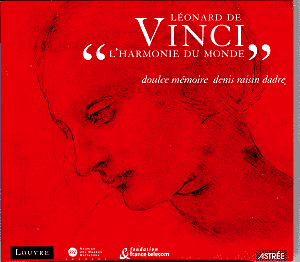One wouldn’t immediately associate the Italian
renaissance painter and scientist Leonardo da Vinci with music.
But he actually was a musician himself, and a very good one at
that. The renaissance ideal was the ‘uomo universale’ and education
aimed to teach as many skills as possible. No education was complete
without music.
In his collection of biographies of the artists
of his time, Vasari describes a number of architects, painters
and sculptors which were also musicians, among them Da Vinci’s
teacher Andrea Verrocchio. Da Vinci learned to play the ‘lira
da braccio’. This instrument was very popular in the renaissance,
as it was associated with Orpheus and Apollo. The booklet says,
"The lira da braccio (...) has seven strings (..), two of
which act as a drone. The flat bridge allows for chords to be
played. (...) The lira was used to accompany singing, and because
of the absence of a bass-bar or soundposts its harmonic spectrum
was very wide: it created a halo around the voice, giving it greater
eloquence, and thus enhancing the expressive power of Renaissance
orators, poets and musicians."
One popular form of playing the lira da braccio
was ‘cantar alla viola’, where the player improvised poetry or
recited works from the Roman and Greek antiquity to his own accompaniment.
Because of the improvised nature of lira-playing no examples of
this practice have come down to us. This CD contains one piece
which gives some idea of what such an improvisation may have sounded
like: the frottola ‘Voi che passate’ by Francisco Varoter.
Leonardo da Vinci travelled a lot. It brought
along the idea of selecting music associated with the cities Da
Vinci visited. Since sacred music was more or less universal in
character, the choice was made to concentrate on secular music,
which varied from one city to the other.
The ‘journey’ begins in Florence, where Leonardo
da Vinci was born and spent the first 30 years of his life. Strangely
enough, only one track is associated with Florence. After that
Milan (1490 – 1499), Mantua (1499 – 1501), Rome (1513 – 1517)
follow. In 1517 Leonardo went to France at the invitation of François
I. Therefore the last section of this recording is devoted to
French music.
Since Da Vinci played the lira da braccio this
instrument does appear in a number of tracks. There is a picture
of such an instrument in the booklet, and the instrument sounds
as gorgeous as it looks. It is really a very expressive instrument,
and excellently suited to accompany the voice, as the piece mentioned
above demonstrates. And Frédéric Martin plays it
very well indeed.
The other instrumentalists are also excellent.
And both Anne Quentin and Anne Azéma have beautiful voices,
very appropriate for this kind of music. I particularly liked
the way Ms Azéma sings Tromboncino’s frottola ‘Non val
acqua’. I am a little surprised, though, that in the vocal pieces
of French origin at the end of the CD there is hardly any ornamentation,
although these are all strophic.
I also wondered about the scoring of the ‘Basse
danse’ by Guillaume Faugues. The ‘basse danse’ is described in
the booklet as "the most refined and elegant of the courtly
dances". But in the performance here, with shawms and percussion,
it doesn’t sound very ‘elegant and refined’.
But this CD contains a lot of little known music
and the singing and playing is excellent. This ensemble proves
again that it is one of the most imaginative around. I hope to
hear more from them in the future.
Johan van Veen


